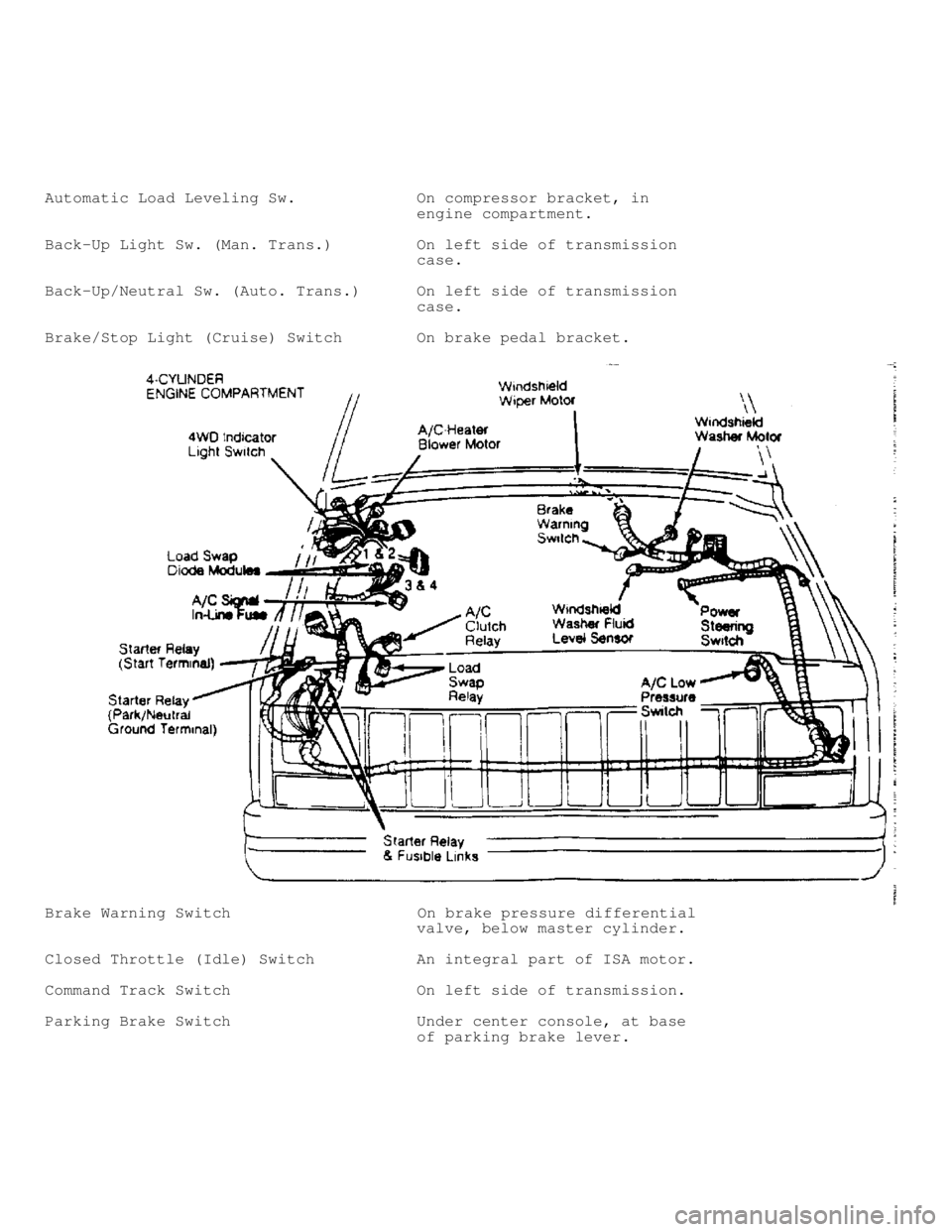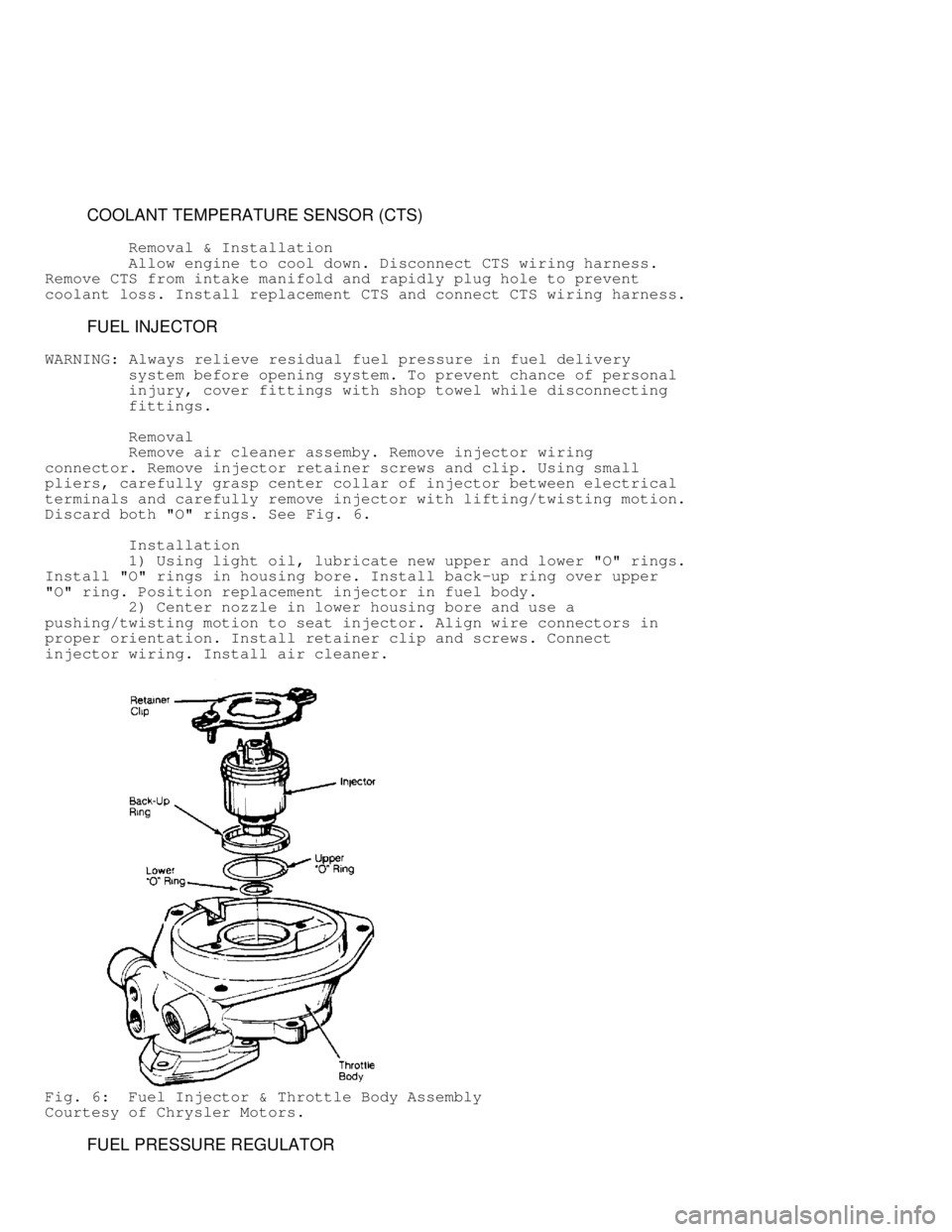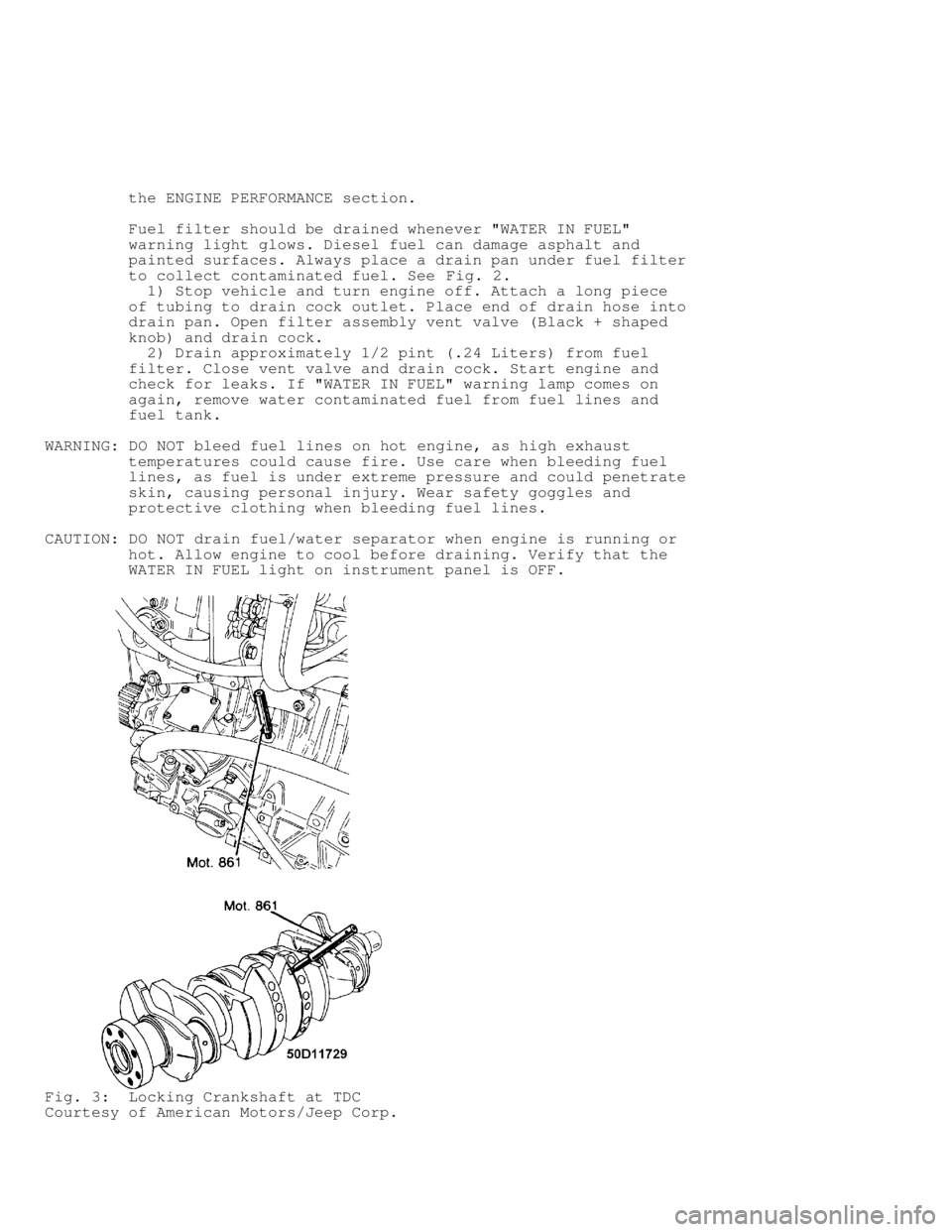1988 JEEP CHEROKEE warning light
[x] Cancel search: warning lightPage 509 of 1378

Automatic Load Leveling Sw. On compressor bracket, in
engine compartment.
Back-Up Light Sw. (Man. Trans.) On left side of transmission
case.
Back-Up/Neutral Sw. (Auto. Trans.) On left side of transmission
case.
Brake/Stop Light (Cruise) Switch On brake pedal bracket.
Brake Warning Switch On brake pressure differential
valve, below master cylinder.
Closed Throttle (Idle) Switch An integral part of ISA motor.\
Command Track Switch On left side of transmission.
Parking Brake Switch Under center console, at base
of parking brake lever.
Page 802 of 1378

COOLANT TEMPERATURE SENSOR (CTS)
Removal & Installation
Allow engine to cool down. Disconnect CTS wiring harness.
Remove CTS from intake manifold and rapidly plug hole to prevent
coolant loss. Install replacement CTS and connect CTS wiring harness.
FUEL INJECTOR
WARNING: Always relieve residual fuel pressure in fuel delivery
system before opening system. To prevent chance of personal
injury, cover fittings with shop towel while disconnecting
fittings.
Removal
Remove air cleaner assemby. Remove injector wiring
connector. Remove injector retainer screws and clip. Using small
pliers, carefully grasp center collar of injector between electrical
terminals and carefully remove injector with lifting/twisting motion.
Discard both "O" rings. See Fig. 6.
Installation
1) Using light oil, lubricate new upper and lower "O" rings.
Install "O" rings in housing bore. Install back-up ring over upper
"O" ring. Position replacement injector in fuel body.
2) Center nozzle in lower housing bore and use a
pushing/twisting motion to seat injector. Align wire connectors in
proper orientation. Install retainer clip and screws. Connect
injector wiring. Install air cleaner.
Fig. 6: Fuel Injector & Throttle Body Assembly
Courtesy of Chrysler Motors.
FUEL PRESSURE REGULATOR
Page 829 of 1378

1 - 25 Amp
Rear Washer/Wiper.
2 - 15 Amp
Radio, Cigarette Lighter.
3 - 25 Amp
Blower Motor.
4 - 20 Amp
Turn Signal, Back-Up Lights, Rear Window Defogger Relay.
5 - 10 Amp
Dome Light, Courtesy Lights, Glove Box Light, Cargo Light,
Radio Memory, Power Mirrors, Teltak Connector.
6 - 15 Amp
Hazard Warning System, Stoplights.
7 - 10 Amp
Parking Lights, Headlight Warning Chime/Buzzer, Instrument
Panel Light Dimmer.
8 - 7.5 Amp
Gauges, Instrument Cluster, Seat Belt Warning, Headlight
Delay, Chime Module, Overhead Console.
9 - 5 Amp
Instrument Panel Illumination.
10 - 25 Amp
Rear Window Defogger.
11 - 30 Amp (Circuit Breaker)
Power Door Locks, Power Seats, Trailer Towing Wiring Harness.
12 - 10 Amp
ETR Radio, Power Antenna.
13 - Not Used (1984-87); 7.5 Amp (1988)
Transmission Control Unit.
14 - 25 Amp
Headlight Delay, Horns, Security Alarm.
15 - 5.5 Amp (Circuit Breaker)
Front Wiper.
16 - 30 Amp (Circuit Breaker)
Power Windows.
17 - 10 Amp
Clock, Security Alarm (Ign).
CAUTIONS & WARNINGS
REPLACING BLOWN FUSES
Before replacing a blown fuse, remove ignition key, turn off
all lights and accessories to avoid damaging the electrical system. Be
sure to use fuse with the correct indicated amperage rating. The use
of an incorrect amperage rating fuse may result in a dangerous
Page 906 of 1378

the ENGINE PERFORMANCE section.
Fuel filter should be drained whenever "WATER IN FUEL"
warning light glows. Diesel fuel can damage asphalt and
painted surfaces. Always place a drain pan under fuel filter
to collect contaminated fuel. See Fig. 2.
1) Stop vehicle and turn engine off. Attach a long piece
of tubing to drain cock outlet. Place end of drain hose into
drain pan. Open filter assembly vent valve (Black + shaped
knob) and drain cock.
2) Drain approximately 1/2 pint (.24 Liters) from fuel
filter. Close vent valve and drain cock. Start engine and
check for leaks. If "WATER IN FUEL" warning lamp comes on
again, remove water contaminated fuel from fuel lines and
fuel tank.
WARNING: DO NOT bleed fuel lines on hot engine, as high exhaust
temperatures could cause fire. Use care when bleeding fuel
lines, as fuel is under extreme pressure and could penetrate
skin, causing personal injury. Wear safety goggles and
protective clothing when bleeding fuel lines.
CAUTION: DO NOT drain fuel/water separator when engine is running or
hot. Allow engine to cool before draining. Verify that the
WATER IN FUEL light on instrument panel is OFF.
Fig. 3: Locking Crankshaft at TDC
Courtesy of American Motors/Jeep Corp.
Page 915 of 1378

BATTERY SPECIFICATIONS
CAUTION: When battery is disconnected, vehicles equipped with
computers may lose memory data. When battery power is
restored, driveability problems may exist on some vehicles.
These vehicles may require a relearn procedure. See COMPUTER
RELEARN PROCEDURES article in the GENERAL INFORMATION
section.
All gasoline engine equipped models use group 58 batteries
with 390 or 475 amp cold crank rating. Models with 2.1L Turbo Diesel
engine use group 24 batteries with a 815 amp cold crank rating.
CAUTIONS & WARNINGS
REPLACING BLOWN FUSES
Before replacing a blown fuse, remove ignition key, turn off
all lights and accessories to avoid damaging the electrical system. Be
sure to use fuse with the correct indicated amperage rating. The use
of an incorrect amperage rating fuse may result in a dangerous
electrical system overload.
BATTERY WARNING
WARNING: When battery is disconnected, vehicles equipped with
computers may lose memory data. When battery power is
restored, driveability problems may exist on some vehicles.
These vehicles may require a relearn procedure. See COMPUTER
RELEARN PROCEDURES article in GENERAL INFORMATION section.
BRAKE PAD WEAR INDICATOR
Indicator will cause a squealing or scraping noise, warning
that brake pads need replacement.
DIESEL FUEL ANTI-FUNGAL ADDITIVES
CAUTION: If fuel contamination due to fungi or other microorganisms is
suspected a fuel additive with a biocide may be used. Follow
the manufacturers dosage as recommended on product label. Use
biocides ONLY when necessary, excessive use can may cause
other fuel system problems.
DIESEL FUEL CONTAMINATION
WARNING: Diesel fuel system may be contaminated with fungi or other
microorganisms. Keep contaminated fuel away from open skin
cuts or sores to prevent skin irritation or infection.
DIESEL FUEL REQUIREMENTS
CAUTION: All diesel engines are to use Diesel Fuel #2 when the outside
temperature is above 20\bF (-7\bC). In temperatures that are
below 20\bF (-7\bC) use Diesel Fuel #1, this will reduce the
chance of the fuel thickening and forming wax.
Note: A Diesel Fuel #1 & #2 combination (Blended Fuel) may be\
used, and is recommended for mild winter driving.
Page 916 of 1378

ELECTROSTATIC DISCHARGE SENSITIVE (ESD) PARTS
WARNING: Many solid state electrical components can be damaged by
static electricity (ESD). Some will display a warning label,
but many will not. Discharge personal static electricity by
touching a metal ground point on the vehicle prior to
servicing any ESD sensitive component.
ENGINE OIL
CAUTION: Never use non-detergent or straight mineral oil.
CAUTION: Do not use reclaimed fluid, mineral oil, fluid that was
stored in old or open containers, or fluid inferior to AMC
Standard AM 4101. Be sure to handle the fluid in clean
containers that will not introduce even a slight amount of
foreign liquids or particles. Such contamination of fluid
could lead to hydraulic system failure.
ENGINE OIL FILTER (GASOLINE)
CAUTION: Verify that proper Oil Filter is being used. Filters with
metric threads (M20 x 1.5) must be used with some engines.
Other engines use SAE type (3/4" x 16) threads, and must
use an oil filter with these threads. Possible engine damage
can occur with improper oil filter.
ENGINE OIL FILTER (TURBO DIESEL ONLY)
CAUTION: The engine oil filter has METRIC threads. Use of a filter
with improper threads can result in oil leakage and
possible engine damage. Look for thread size symbol M20x1.5
on filter.
FUEL SYSTEM SERVICE
WARNING: DO NOT bleed fuel lines on hot engine, as high exhaust
temperatures could cause fire. Use care when bleeding fuel
lines, as fuel is under extreme pressure and could penetrate
skin, causing personal injury. Wear safety goggles and
protective clothing when bleeding fuel lines.
WARNING: Relieve fuel system pressure prior to servicing any fuel
system component.
HALOGEN BULBS
Halogen bulbs contain pressurized gas which may explode if
overheated. DO NOT touch glass portion of bulb with bare hands. Eye
protection should be worn when handling or working around halogen
bulbs.
RADIATOR CAP
CAUTION: Always disconnect the fan motor when working near the
radiator fan. The fan is temperature controlled and could
start at any time even when the ignition key is in the OFF
position. DO NOT loosen or remove radiator cap when cooling
system is hot.
STARTING FLUID USE (TURBO DIESEL)
Page 920 of 1378

1 - 25 Amp
Rear Washer/Wiper
2 - 15 Amp
Radio, Cigarette Lighter
3 - 25 Amp
Blower Motor
4 - 20 Amp
Turn Signal, Back-Up Lights, Rear Window Defogger Relay
5 - 10 Amp
Dome Light, Courtesy Lights, Glove Box Light, Cargo Light,
Radio Memory, Power Mirrors, Teltak Connector
6 - 15 Amp
Hazard Warning System, Stoplights
7 - 10 Amp
Parking Lights, Headlight Warning Chime/Buzzer, Instrument
Panel Light Dimmer
8 - 7.5 Amp
Gauges, Instrument Cluster, Seat Belt Warning,
Headlight Delay, Chime Module, Overhead Console
9 - 5 Amp
Instrument Panel Illumination
10 - 25 Amp
Rear Window Defogger
11 - 30 Amp (Circuit Breaker)
Power Door Locks, Power Seats, Trailer Towing Wiring Harness
12 - 10 Amp
ETR Radio, Power Antenna
13 - Not Used (1984-87)
7.5 Amp (1988)
Transmission Control Unit
14 - 25 Amp
Headlight Delay, Horns, Security Alarm
15 - 5.5 Amp (Circuit Breaker)
Front Wiper
16 - 30 Amp (Circuit Breaker)
Power Windows
17 - 10 Amp
Clock, Security Alarm (IGN)
Page 951 of 1378

computers may lose memory data. When battery power is
restored, driveability problems may exist on some vehicles.
These vehicles may require a relearn procedure. See COMPUTER
RELEARN PROCEDURES article in GENERAL INFORMATION section.
REPLACING BLOWN FUSES
Before replacing a blown fuse, remove ignition key, turn off
all lights and accessories to avoid damaging the electrical system. Be
sure to use fuse with the correct indicated amperage rating. The use
of an incorrect amperage rating fuse may result in a dangerous
electrical system overload.
BRAKE PAD WEAR INDICATOR
Indicator will cause a squealing or scraping noise, warning
that brake pads need replacement.
BRAKE WARNING LIGHT
CAUTION: If BRAKE warning light is on with parking brake disengaged
and engine running, there may be a problem in the hydraulic
brake system. Braking effort, brake pedal travel and
stopping distances may increase.
CATALYTIC CONVERTER
To prevent catalytic converter overheating, DO NOT allow
engine to idle for more than 20 minutes.
COMMAND-TRAC (4WD)
CAUTION: NEVER operate a Command-Trac vehicle in 4WD on dry,
hard-surfaced roads for a sustained period. Use 4L only
when needed for added pulling power. Operating vehicle in
4WD mode on such roads will cause stress and possible
damage to components, as well as make shifting difficult.
To reduce shifting effort, drive vehicle in Reverse for a
few feet, or drive off hard-surfaced road momentarily to
allow tire slippage.
FRONT AND REAR DIFFERENTIALS (4WD)
CAUTION: DO NOT use water, steam, kerosene or gasoline for flushing
a differential. ONLY use a flushing oil.
TRAC-LOK DIFFERENTIALS (4WD)
CAUTION: DO NOT flush a rear axle Trac-Lok differential. Trac-Lok
differentials may be cleaned only by disassembling the
unit and wiping the components with clean, lint-free cloth.
CAUTION: NEVER attempt to engage Low range when vehicle is moving
faster than 2-3 MPH, as transfer case damage may result.
GASOLINE CONTAINING ALCOHOL
CAUTION: Exclusive use of gasohol is not recommended. Vehicle test
results have shown that significant fuel system corrosion
can result when gasohol is used exclusively.